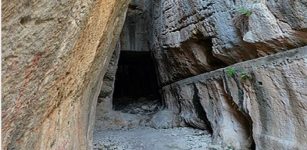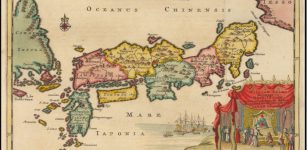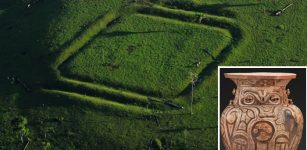First Sumerian Revolt – People Oppose The Harsh Akkadian Empire
A. Sutherland - AncientPages.com - We tend to focus on ancient Sumerian inventions, their significant architectural accomplishments, and their vast scientific knowledge.
Ancient Sumerian clay tablets are praised and admired by archaeologists, historians, and anyone interested in ancient civilizations.
Prisoners escorted by a soldier, on a victory stele of Sargon of Akkad, circa 2300 BC. The hairstyle of the prisoners (curly hair on top and short hair on the sides) is characteristic of Sumerians, as also seen on the Standard of Ur. Louvre Museum. Image credit: ALFGRN - - CC BY-SA 2.0
But what we do not discuss so often is Sumer's turbulent history with all its revolts and wars.
Lugalzagesi Achieved Much Before Sargon the Great Appeared On The Scene
For a short time, around 2350 BC, King Lugalzagesi united the city-states of Sumer by defeating each in turn. He was the last Sumerian king before Sumer's conquest by Sargon of Akkad and the rise of the Akkadian Empire.
After 25 years of rule, Lugalzagesi was defeated by Sargon, later called the Great, a skilled politician who united the independent regions of Sumer into one state. His kingdom is today widely considered the first empire in the world.
Thus, Sargon, who reigned from c. 2334 to 2284 BC, became king over southern Mesopotamia. His vast power extended far beyond Mesopotamia, reaching into Syria and Lebanon in the west, the Elam state in the east, and the Taurus Mountains in Turkey in the north. He had a well-organized army capable of making new conquests and a well-organized, administered centralized Sumerian state. His inscriptions confirm his access to significant land and sea trade routes.
At the time of Sargon's death, his son Rimush became the Akkadian Empire ruler and reigned c. 2284–2276 BC as the King of Akkad. Ancient sources confirm that some Sumerian city-states immediately rebelled against their Akkadian governors and their supporters and replaced them with Sumer rulers and councils almost as soon as Sargon died.
Why Did The Rebels Have To Give Up Their Fight?
Not much is known about this historical and very turbulent period. However, it is known that cities like Lagash, Kazallu, Ur, Adab, Zabala, Kidingira, and Umma had a well-organized resistance against the rule of the Akkadians in Mesopotamia.
In the end, wealthy and influential Sumerians had to accept the rule of Akkadian governors. Rimush confronted extensive opposition from the Sumerian cities, and according to his inscriptions, he had to repress widespread revolts in the Sumerian cities at the beginning of his reign.
Samuel Noah Kramer writes that "in bitter battles involving tens of thousands of troops, he [Rimush] conquered or rather reconquered, the cities of Ur, Umma, Adab, Lagash, Der, and Kazallu, as well as the countries of Elam and Barahshi. 1

Akkadian Empire map. Image source
Rimush even organized a successful campaign against Elam and returned home with rich booty. He ruled only nine years, and his short reign was not much more than suppressing revolts amongst the people who his father had conquered. And yet, the real threat to his rule came not from these rebellions but from much closer to home. As a precaution against future uprisings, he destroyed city walls and other defensive structures in many Sumerian city-states.
Was it enough to stop dissatisfaction, uprisings, and other forms of discontent?
Did Manishtushu Assassinate His Younger Brother Rimush?
It is not precisely known what happened to Rimush, but it seems that he was assassinated. He was followed by elder brother Manishtushu, who probably violently "removed" Rimush from the throne in 2,270 BC.
Interestingly, the two brothers continued to rule using their father's political and military patterns.
Military encounters between Akkadian and Sumerian forces were bloody. The fightings were fierce and cost many casualties. It has been estimated that as many as twenty thousand Sumerian troops may have been killed, captured, and sold into slavery. That probably represented up to one-third of the number of fighting men from the rebelling Sumer cities.
There has been speculated that Manishtushu was part of a conspiracy to kill Rimush and take the throne, but was it necessary to kill their younger brother?
Rimush successfully suppressed revolts within the Akkadian Empire, and Manishtushu could freely begin building trade routes, gathering a substantial fleet of warships. His goal was also to extend and strengthen the Akkadian Empire. One of Manishtushu's inscriptions says:
"When he [Manishtushu] had crossed the Lower Sea (it means the Persian Gulf) in ships, thirty-two kings gathered against him, but he defeated them and smote their cities and prostrated their lords and destroyed [the whole countryside] as far as the silver mines." 2
Yet Another Assassination And New Revolts
However, in 2,255 BC, Manishtushu, like his brother Rimush, was assassinated after fifteen years of rule.
Rimush and Manishtushu and all the successors of Sargon struggled with raids of foreign tribes and rebellions of Sumerian cities. During Naram-Sin's reign, a great rebellion broke out.
Naram-Sîn reigned 2261-2224 B.C and was the last great king of the Akkadian Empire and Sargon's grandson. He was considered the most prominent Akkadian king after Sargon. He, too, had many problems with the revolts and rebels.
The whole country revolted against him, and the uprising had two leaders; one led the north's cities, and the other stood at the head of the south's towns.
Naram-Sin suppressed both rebellions and retained power and during his reign, the Akkadian empire was at least as large as under Sargon and probably even more extensive.
Written by – A. Sutherland - AncientPages.com Senior Staff Writer
Updated on October 06, 2023
Copyright © AncientPages.com All rights reserved. This material may not be published, broadcast, rewritten or redistributed in whole or part without the express written permission of AncientPages.com
Expand for referencesReferences:
1 S. N. Kramer The Sumerians
History, Innovating. The Sumerians: A Complete Guide to Sumerian History And The Sumerian Civilization.
Hamblin, William J. Warfare in Ancient Near East to 1600 BC
More From Ancient Pages
-
 On This Day In History: Last Inca Emperor Atahualpa Captured By Francisco Pizarro – On Nov 16, 1532
News | Nov 16, 2016
On This Day In History: Last Inca Emperor Atahualpa Captured By Francisco Pizarro – On Nov 16, 1532
News | Nov 16, 2016 -
 Scribes: One Of The Noblest And Highly Recommended Professions In Ancient Egypt
Featured Stories | May 10, 2023
Scribes: One Of The Noblest And Highly Recommended Professions In Ancient Egypt
Featured Stories | May 10, 2023 -
 Spectacular Ancient Underground ‘Stonehenge’ Dolmen De Soto Reveals Its Secrets
Archaeology | Apr 18, 2019
Spectacular Ancient Underground ‘Stonehenge’ Dolmen De Soto Reveals Its Secrets
Archaeology | Apr 18, 2019 -
 Lamanai, Belize: One Of The Largest And Oldest Maya Cities Dated To 1500 BC
Civilizations | Nov 2, 2018
Lamanai, Belize: One Of The Largest And Oldest Maya Cities Dated To 1500 BC
Civilizations | Nov 2, 2018 -
 Spectacular Vespasianus Titus Tunnel – An Ancient Roman Engineering Marvel
Ancient Technology | Aug 30, 2018
Spectacular Vespasianus Titus Tunnel – An Ancient Roman Engineering Marvel
Ancient Technology | Aug 30, 2018 -
 Carbonized Herculaneum Papyrus Begins Revealing Its Ancient And Historical Secrets
Artifacts | Apr 24, 2024
Carbonized Herculaneum Papyrus Begins Revealing Its Ancient And Historical Secrets
Artifacts | Apr 24, 2024 -
 Death And Afterlife In Sumerian Beliefs
Civilizations | May 12, 2017
Death And Afterlife In Sumerian Beliefs
Civilizations | May 12, 2017 -
 Spread Of Transeurasian Languages Was Due To Agriculture Study Reveals
Archaeology | Nov 10, 2021
Spread Of Transeurasian Languages Was Due To Agriculture Study Reveals
Archaeology | Nov 10, 2021 -
 Were Mysterious Ancient Man-Made Earthworks In The Amazon Forest Ritual Communication Spaces?
Archaeology | Sep 6, 2017
Were Mysterious Ancient Man-Made Earthworks In The Amazon Forest Ritual Communication Spaces?
Archaeology | Sep 6, 2017 -
 Secrets Of The Japanese Shirasaya Sword Mounting
Featured Stories | Sep 11, 2018
Secrets Of The Japanese Shirasaya Sword Mounting
Featured Stories | Sep 11, 2018 -
 Major Discovery Of Ancient Roman Temple – Largest Evidence Ever Of The Imperial Cult
Archaeology | Jan 5, 2024
Major Discovery Of Ancient Roman Temple – Largest Evidence Ever Of The Imperial Cult
Archaeology | Jan 5, 2024 -
 Mysterious Stone Of The Sky God: Krishna’s Butter Ball Defies All Laws Of Physics
Featured Stories | Aug 20, 2014
Mysterious Stone Of The Sky God: Krishna’s Butter Ball Defies All Laws Of Physics
Featured Stories | Aug 20, 2014 -
 Nahal Mishmar Secrets: Priceless Artifacts In Cliff Cave Overlooking The Dead Sea
Artifacts | May 20, 2014
Nahal Mishmar Secrets: Priceless Artifacts In Cliff Cave Overlooking The Dead Sea
Artifacts | May 20, 2014 -
 9,600-Year-Old Permament Settlement And Daily Tools Discovered In Turkey
Archaeology | Sep 2, 2022
9,600-Year-Old Permament Settlement And Daily Tools Discovered In Turkey
Archaeology | Sep 2, 2022 -
 Elysian Fields: Mysterious Resting Place For Heroic And Virtuous Souls In Greek Ancient Beliefs
Featured Stories | Feb 20, 2020
Elysian Fields: Mysterious Resting Place For Heroic And Virtuous Souls In Greek Ancient Beliefs
Featured Stories | Feb 20, 2020 -
 Ancient Greeks In Ukraine: 2000-Year-Old Settlement With Previously Unknown Structures – Localized By Polish Archaeologists
Archaeology | Nov 15, 2015
Ancient Greeks In Ukraine: 2000-Year-Old Settlement With Previously Unknown Structures – Localized By Polish Archaeologists
Archaeology | Nov 15, 2015 -
 Ancient DNA Reveals Missing Link In The History Of Indo-European Languages
Linguistic Discoveries | Feb 5, 2025
Ancient DNA Reveals Missing Link In The History Of Indo-European Languages
Linguistic Discoveries | Feb 5, 2025 -
 Vindelev Treasure – Surprising Evidence Of Nordic Connection With The European Iron Age Elite
Archaeology | Apr 9, 2024
Vindelev Treasure – Surprising Evidence Of Nordic Connection With The European Iron Age Elite
Archaeology | Apr 9, 2024 -
 The Navajo People In The Land Of The Four Sacred Mountains
Civilizations | Jun 10, 2020
The Navajo People In The Land Of The Four Sacred Mountains
Civilizations | Jun 10, 2020 -
 Great Easter Traditions Passed Down Over Centuries And Widely Practiced
Ancient History Facts | Mar 25, 2016
Great Easter Traditions Passed Down Over Centuries And Widely Practiced
Ancient History Facts | Mar 25, 2016

